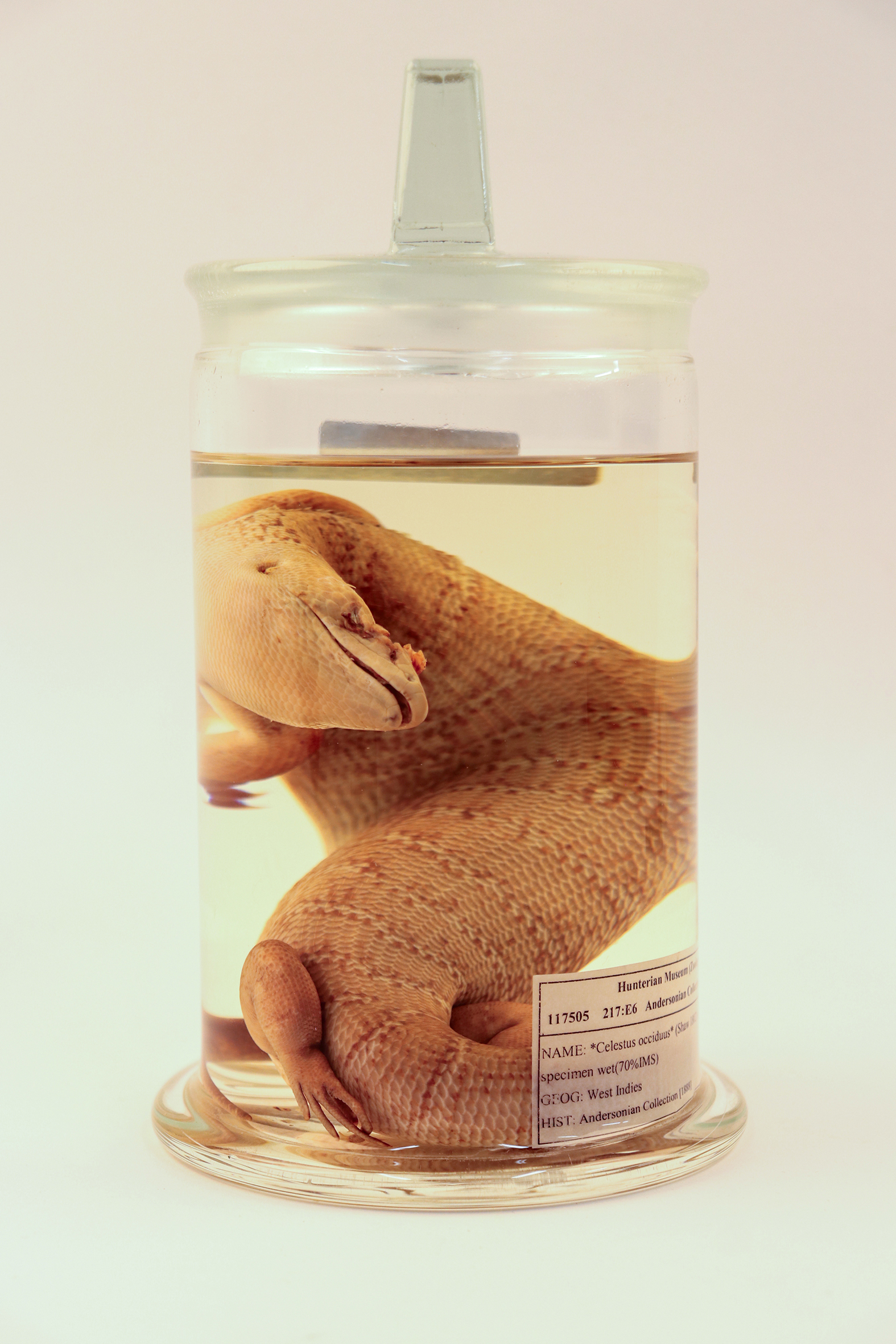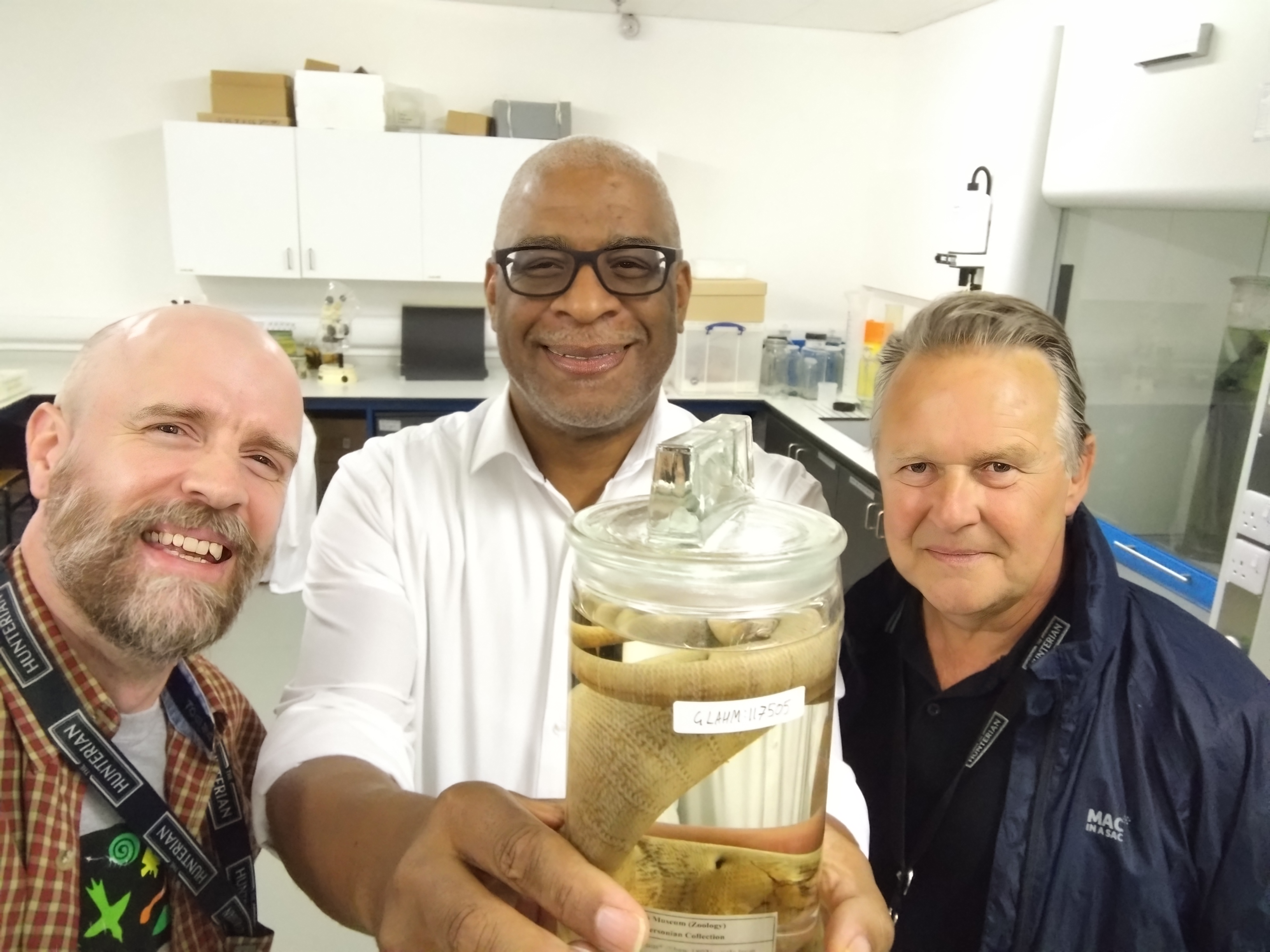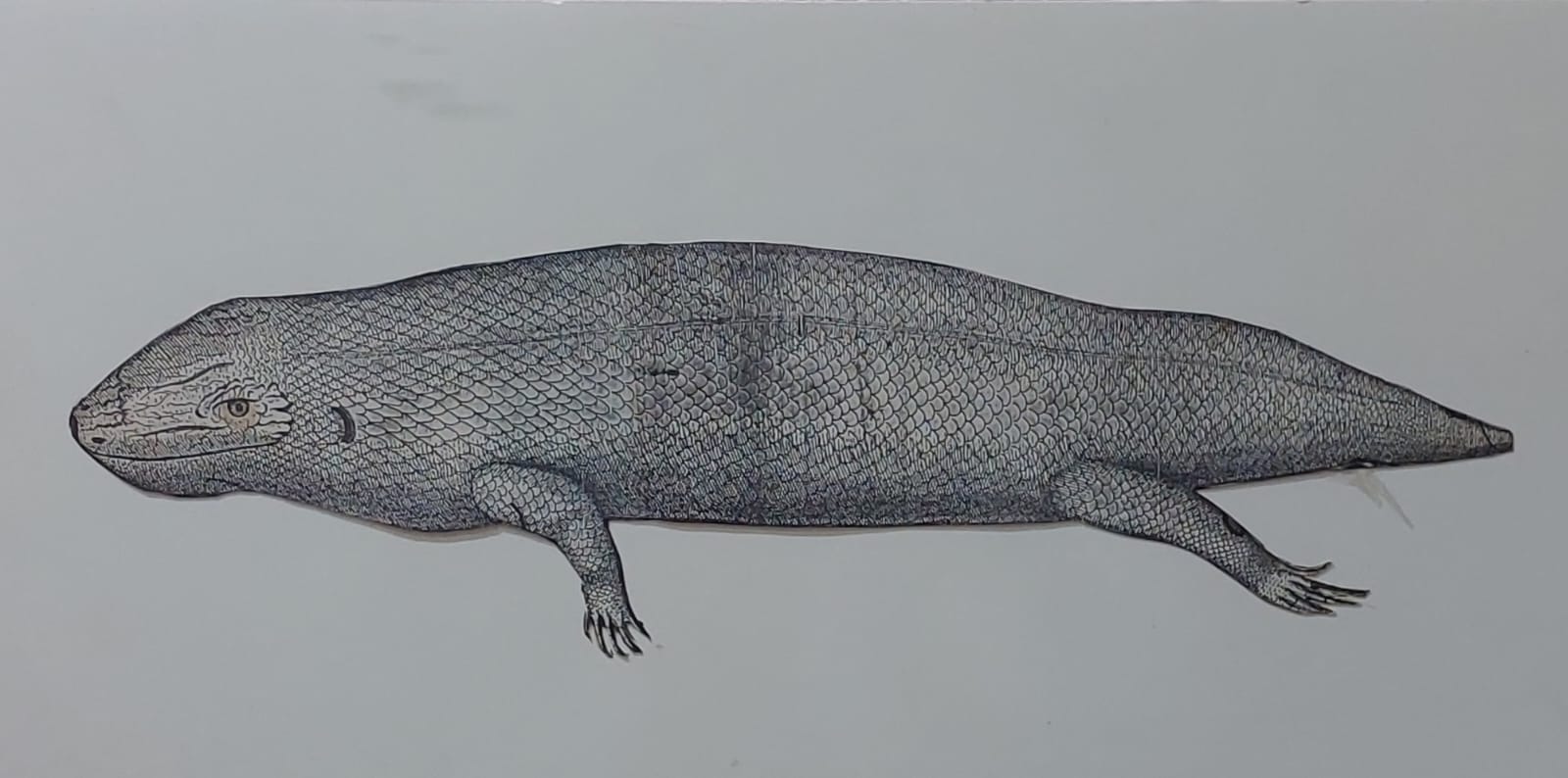News Releases
The UWI and University of Glasgow partner to repatriate 170-year-old Jamaican Giant Galliwasp
For Release Upon Receipt - April 18, 2024
UWI
The UWI Regional Headquarters, Jamaica. Thursday, April 18, 2024—The University of the West Indies (The UWI) and the University of Glasgow (UofG) have announced the repatriation of a Jamaican Giant Galliwasp specimen from The Hunterian collection at UofG in Scotland, UK. The species of lizard, which is thought to have been collected in the 1850s and is presumed to be extinct, will return to its homeland, Jamaica. This repatriation exercise is momentous as it is the first repatriation of a natural history specimen in the Caribbean. It symbolises an important milestone for scientific research, cultural heritage preservation in the region, and repatriation as part of the reparatory justice for the Caribbean.
A joint team from The UWI and the Institute of Jamaica (IOJ) will travel to Glasgow to retrieve the specimen. The team includes Dr Shani Roper, Curator at The UWI Museum, Elizabeth Morrison, Zoologist Curator at IOJ, Museum, Dr Tannice Hall, Lecturer in The UWI Life Sciences, and Dionne Newell, Senior Research Officer in Entomology at IOJ, and Desireina Delancy, Graduate Student, The UWI, Mona. The team returns to Jamaica with the lizard specimen on April 24.
This repatriation exercise is within the sphere of the execution of a 2019 Memorandum of Understanding (MOU) between The UWI and UofG, aimed at fostering collaboration in research and education and addressing the historical legacies of colonialism. One of the most tangible outcomes of the MOU is the Glasgow-Caribbean Centre for Development Research (GCCDR), which funds research projects that advance development goals in the Caribbean, facilitate academic partnerships, and raise global awareness about the ongoing impact of historical slavery. This repatriation not only represents the return of a valuable piece of Jamaican heritage but also signifies a commitment by the UofG to rectify past injustices and ensure Caribbean ownership of its scientific and cultural treasures.
According to Vice-Chancellor of The UWI, Professor Sir Hilary Beckles, “The reparatory justice movement deals with various issues of different scales that must be addressed. By returning the Galliwasp to its rightful place, we take a small but significant step towards laying the foundation for a regional and international discussion on repatriation.”
Professor Simon Anderson, Professor of Population Health Sciences at The UWI Cave Hill Campus and Board Director of the GCCDR expressed, “The Glasgow-Caribbean Centre for Development Research has contributed to the Galliwasp’s repatriation as it sees this initiative as a way of further strengthening the relationship between The UWI and UofG. We hope that this visit and the return of the Jamaican Giant Galliwasp will spur new research and collaborations.”
Steph Scholten, Director of The Hunterian, University of Glasgow, said, “The Jamaican Giant Galliwasp lizard specimen that will return to its homeland Jamaica, became part of our collections in 1888. It was selected for interpretation and display in the Hunterian Museum by Professor Churnjeet Mahn, one of the Community Curators who worked on The Hunterian’s ‘Curating Discomfort’ project. This is part of The Hunterian’s active and critical engagement with its historic legacy, making it a more meaningful place for more diverse audiences. We hope that this return will help foster further relationships between The University of the West Indies and the University of Glasgow, as well as deepen understanding of repatriation issues in the museum sector.”
The partnership between The UWI and the UofG for the return of the Galliwasp represents their continuous commitment to social justice and cultural equity. This initiative is in line with other ongoing strategic efforts between the two institutions, such as the joint Master's Programme in Reparatory Justice. This unique interdisciplinary programme comprises courses with a historical basis and a connection with present-day realities, with the primary goal of facilitating a deeper understanding of the demand for reparations justice.
Upon the specimen’s return to Jamaica, an official handover ceremony will be held as it will be deposited in the Natural History Museum of Jamaica on permanent loan in the national flora and fauna collection for safekeeping and allowing it to be accessible to all Jamaicans.
Members of the public are invited to stay tuned to follow the repatriation journey of the Jamaican Giant Galliwasp from Scotland to its homeland.
End
Further Information
The specimen is a Jamaican Giant Galliwasp (Celestus occiduus), an endemic species, meaning it has only ever been found in Jamaica.
Giant Jamaican Galliwasps were last confirmed alive in the 1800s but the species is now considered to be extinct. Their disappearance was due to the sugar cane plantation economy, which caused a loss of natural habitat and introduced predators such as rats to the island.
Before they became extinct, galliwasp specimens were collected and sent to various museums in Europe and the USA. Some were held by the Institute of Jamaica but are thought to have been lost during the 1907 Kingston earthquake.
The Hunterian specimen became part of the University of Glasgow collections in 1888 following the transfer of ethnographical and zoological specimens from another Glasgow collection, the Andersonian Museum. Information about how it came to the Andersonian is limited, the only details being the species name and country of origin on the label of the original jar.
The lizard is a mature adult and in good condition for a wet preserved specimen which is potentially over 170 years old. It is currently contained in a glass stoppered jar and stored in 70% ethanol.

Wet specimen of the Jamaican Giant Galliwasp (Celestus occiduus) endemic species courtesy The Hunterian, University of Glasgow

(L-R) Mike Rutherford, Zoology Curator, The Hunterian, University of Glasgow, Professor Simon Anderson, Board Director of the GCCDR holding the wet specimen of the Jamaican Giant Galliwasp and Steph Scholten, Director, The Hunterian, University of Glasgow. Photo Courtesy Mike G. Rutherford

A drawing of the Jamaican Giant Galliwasp (Celestus occiduus) from Sir Hans Sloane, 1725, in A voyage to the islands Madera, Barbados, Nieves, St. Christophers and Jamaica
About The Hunterian
The oldest public museum in Scotland, with collections spanning arts, sciences and humanities, The Hunterian is at the forefront of university museums around the world. Since it opened at the University of Glasgow in 1807, The Hunterian has been an invaluable academic and community resource and in years to come, The Hunterian is committed to becoming a more meaningful place for more diverse audiences.
As a university gallery and museum, The Hunterian creates space for intellectual inquiry and a process of learning and experimentation. The Hunterian collection’s Enlightenment history made a repository of knowledge that materialises the problematic history of Western modernity and its fundamentally colonial and capitalist underpinnings. The founding collection came through the bequest of Dr William Hunter (1718-1783) and since The Hunterian opened at the University of Glasgow in 1807, the collections have been developed in ways that reflect our city’s deep relationship with empire, transatlantic slavery, colonialism and migration.
The Hunterian cares for some of Scotland's finest collections that cover subjects as diverse as the history of medicine, zoology and art. The whole collection is ‘Recognised’ as nationally significant in Scotland and includes outstanding Roman artefacts from the Antonine Wall; vast natural and life science collections; scientific instruments used by James Watt, Joseph Lister and Lord Kelvin; one of the world’s greatest collections of coins and medals and objects and belongings brought to Glasgow from around the world during hundreds of years of trade, empire, exploitation and migration.
The Hunterian is also home to one of the most distinguished public art collections in Scotland and features works by James McNeill Whistler, the Glasgow Boys and Scottish Colourists, the largest single holding of the work of artists Margaret MacDonald and Charles Rennie Mackintosh, along with The Mackintosh House, the reassembled interiors from their Glasgow home. The Hunterian has also developed an important collection of works by leading contemporary artists including Christine Borland, Lucy Skaer and Adam Pendleton.
glasgow.ac.uk/hunterian
Twitter @hunterian
Facebook @HunterianGlasgow
Instagram hunterianglasgow
About The University of the West Indies
The UWI has been and continues to be a pivotal force in every aspect of Caribbean development, residing at the center of all efforts to improve the well-being of people across the region for over 75 years.
From a university college of London in Jamaica with 33 medical students in 1948, The UWI is today an internationally respected, global university with nearly 50,000 students and five campuses: Mona in Jamaica, St. Augustine in Trinidad and Tobago, Cave Hill in Barbados, Five Islands in Antigua and Barbuda and its Global Campus, and global centres in partnership with universities in North America, Latin America, Asia, Africa, and Europe.
The UWI offers over 1000 certificate, diploma, undergraduate and postgraduate degree options in Culture, Creative and Performing Arts, Food and Agriculture, Engineering, Humanities and Education, Law, Medical Sciences, Science and Technology, Social Sciences, and Sport. As the Caribbean’s leading university, it possesses the largest pool of Caribbean intellect and expertise committed to confronting the critical issues of our region and the wider world.
The UWI has been consistently ranked among the best in the world by the most reputable ranking agency, Times Higher Education (THE). Since The UWI’s 2018 debut in THE’s rankings, it has performed well in multiple schemes—among them including World University Rankings, Golden Age University Rankings (between 50 and 80 years old), Latin America Rankings, and the Impact Rankings for its response to the world’s biggest concerns, outlined in the 17 United Nations Sustainable Development Goals (SDGs), including Good Health and Well-being; Gender Equality and Climate Action.
Learn more at www.uwi.edu
Contact
Marketing and Communications Department
- Tel.: (868)-662-2002 ext.2013/2014
- Email: marketing.communications@sta.uwi.edu

